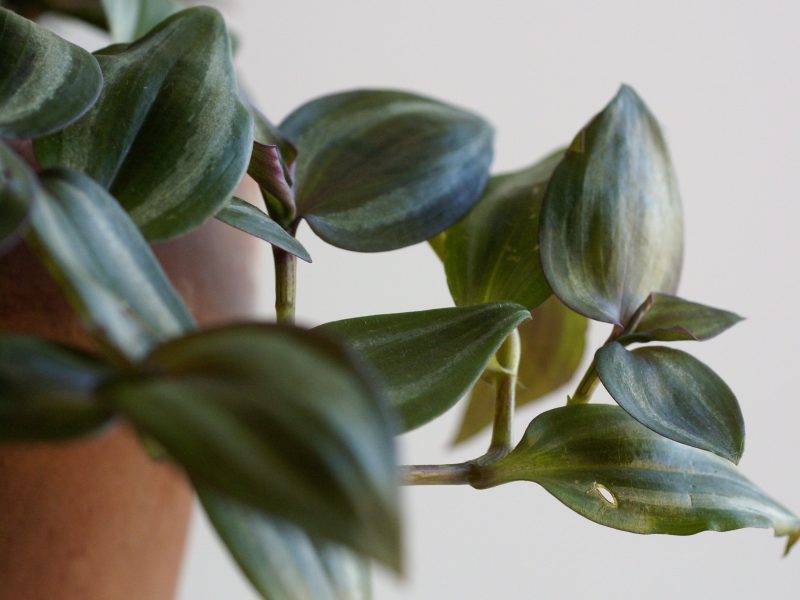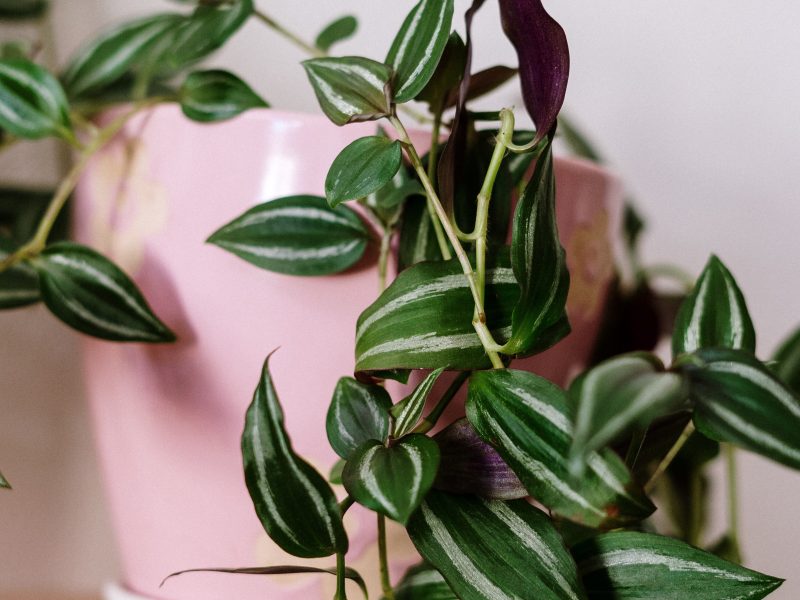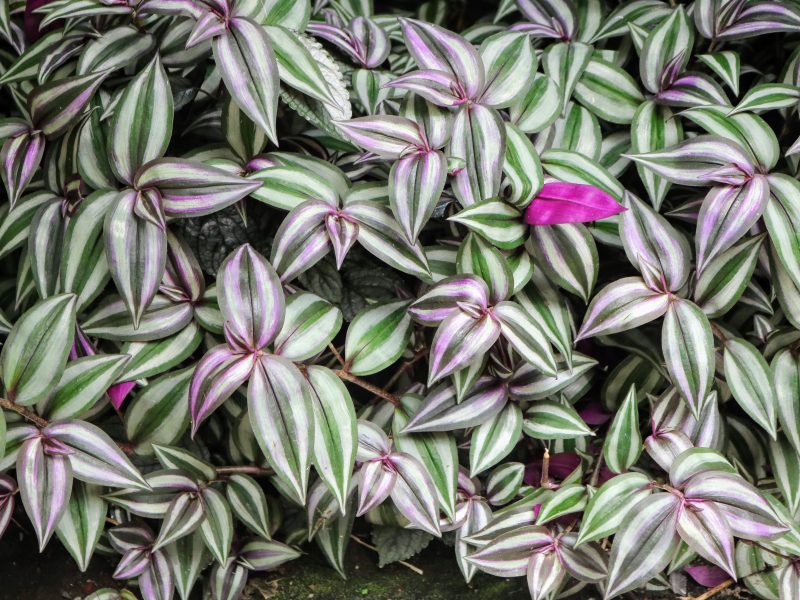Inch Plant (Spiderwort)

Inch Plants are one of our favourite houseplants to take care of as they seem to grow bigger and wilder every day and are pretty low-maintenance too.
Native to Mexico, Central America, and Colombia, the Tradescantia zebrina is a fast-growing houseplant loved for its purple and silver striped foliage. It’s very unique in its appearance and stands out in any urban jungle.
The Inch Plant has several well-used names including Wandering Jew Plant, Flowering Inch Plant and Spiderwort. It’s also often referred to by its Latin name Tradescantia zebrina
In our detailed Inch Plant care guide, we will cover everything you need to know to keep your plant thriving including environmental requirements and diagnosing/treating common problems.
How to care for an Inch Plant
There are three main elements to ensure a healthy Inch Plant. Firstly, ensuring that your plant gets enough bright, indirect sunlight. You want to avoid too much direct sun as this can scorch and fade the leaves and a long time in low light will create small leaves and leggy vines.
The second main element of Inch Plant care is, of course, watering. Wandering Jew Plants love even moisture in the soil and will struggle if the potting mix either dries out for extended periods of time, or is extremely waterlogged. Monitor the soil moisture and adjust your watering routine accordingly.
The third pillar of Wandering Jew Plant care is pruning and this is often forgotten. Pruning the vines back helps to promote strong healthy new growth but it’s especially important for these plants. As they mature, the vines will naturally lose a lot of their oldest leaves at the top of the vine. This can make the plant appear quite leggy and doesn’t look great. Cutting the vines back and propagating them will help ensure a bushy plant.
Inch Plant Overview
Origin: Mexico, Central America, and Colombia
Latin Name: Tradescantia zebrina
Common Name(s): Inch Plant, Inch plant, Flowering Inch Plant, Wandering Jew Plant and Spiderwort
Plant Family: Commelinaceae
Difficulty Level: Moderate
Appearance: Purple foliage with silver, white or grey stripes across the leaf.
Height and Size: 6 feet (2 meters) long
Growth Rate: Fast
Flowering: Can occasionally grow small pink or purple flowers
Pruning: Regular pruning is required to maintain healthy growth.
Cleaning: Dust regularly to prevent a build-up on the leaves
Light Requirements: Bright, indirect sunlight
Water Requirements: Water weekly in spring and summer and fortnightly in autumn and winter to ensure even moisture in the soil
Best Soil: Standard houseplant mix with well-draining qualities
Ideal temperature: 65-80°F (18-26°C)
Fertilizing Routine: Apply a well-balanced fertilizer every 2 months during spring and summer only.
Ideal Humidity Level: 45-60% humidity
Propagation: Through vine cuttings
Repotting Frequency: Repot every 1-2 years
Toxicity: The sap is mildly toxic to pets and humans when ingested
Risk of Pests: Rare but risk of aphids, mealybugs, scale insects, thrips, whiteflies and spider mites.
Common Problems: Leggy growth, brown and yellow leaves and faded leaves
Inch Plant Appearance and Size
Inch Plants are trailing houseplants with long vines adorned with purple and silver striped leaves. Given the right care, each of the vines can grow to around 6 feet (2 meters) in length.
Growth Rate of a Tradescantia zebrina
The Wandering Jew Plant is one of the fastest-growing houseplants. They grow new leaves in no time at all and are great to propagate because roots grow on cuttings in just a few days.
It can happen that they become a little leggy at the top of the vines as they become longer so propagating the ends and potting them into the mother plant to give a fuller look.
Care Difficulty Level
The Inch Plant is quite a low-maintenance plant because it can adapt to quite a range of environments. We often recommend them to beginner houseplants as they’ll reward you with plenty of new growth very soon. They are also super easy to propagate too which makes them a great plant to gift to friends and family without needing them to have a green thumb.
Flowers on an Inch Plant
Although uncommon, it can happen that small pink and purple flowers grow on the Inch Plant. These don’t often last longer than a few days but are very cute!
Pruning your Inch Plant
Pruning your Tradescantia zebrina is an important part of the care routine to maintain your plant’s health, and shape, prevent legginess and promote bushier growth.
Vines on an Inch Plant naturally become quite leggy at the top, near the pot as they often lose their oldest leaves. This can make the plant quite bottom-heavy which doesn’t always look great. Pruning these leggy leaves and propagating the section of the vine will help to create a bushier look. Aim to do this every 1-2 years.
When pruning the vines, it’s important to use clean and sharp pruning tools such as pruning shears or scissors. If you roughly cut the vines or break them off, it can damage the vine and make it more difficult for new healthy growth to develop.
Carefully trim the vines just above a leaf node or joint. This is a small bump on the stem from which leaves grow out from. Cutting just above a node encourages new growth to sprout from that point, making the plant fuller and more compact.
But it’s not just leggy growth that you should be pruning but it’s best to remove any dead or dying leaves that may have turned yellow or brown. Once the leaf has discoloured, there is no reversing this so removing it is best.
Dead leaves will naturally fall from your plant but it’s good to remove them yourself as it avoids any energy being wasted trying to revive them.
Cleaning your Tradescantia Zebrina
Make sure you are cleaning your plant’s leaves regularly to prevent a build-up of dust. Not only is the dust damaging to your plant’s health but it makes the leaves appear dull. Giving them a good wipe-over with a damp cloth will make them sparkle again!
If you are struggling to remove dirt or stickiness from the leaves of your Inch Plant, only ever use dish soap on the cloth. Any harsh chemicals can damage the leaves.
Spiderwort as a hanging plant

Light Requirements for a Spiderwort Plant
Bright, indirect light is ideal for an Inch Plant and they will struggle to thrive in darker areas of your home (they can become quite leggy, droopy and turn brown). However, if your plant receives direct sunlight it can fade the leaves which is irreversible. So you want to find a nice light balance.
Water Requirements for an Inch Plant
Inch Plants don’t like their soil to be too dry or waterlogged so you want to find a balance between the two. We recommend watering your plant little and often so that the soil retains some moisture but not enough to cause issues such as root rot.
You should also be adjusting your watering throughout the year, making sure you are watering your Inch Plant less in the colder, winter months. This is because your plant will be in its dormant phase, meaning growth will slow and the demand for water will be less. Watering in winter can often lead to root rot so check the moisture in the soil before watering.
Best Soil for a Tradescantia zebrina
A standard, high-quality houseplant potting mix will suffice for your Inch Plant. It’s worth checking though if the potting mix you are using contains perlite. This is a great ingredient for helping the soil drain better (and avoiding root rot) but it’s also great at promoting aeration of the potting mix too!
Top tip: If your current potting mix doesn’t contain perlite or you can’t find one that does, you can also buy it individually and add it to any mix.
Inch Plant Temperature Needs
A great thing about caring for an Inch Plant is that they aren’t too fussy about the temperature and will grow well in your home regardless. They do tend to prefer slightly cooler temperatures but are happy with warm environments too.
It’s definitely still worth using a digital thermometer to check for hot or cold extremes every so often though as hotspots and freezing drafts will start to cause issues over time.
Inch Plant Fertilizer Requirements
Inch Plants are not heavy feeders and you should only be fertilizing every 2 months during spring and summer. It’s also important to note that you will still see plenty of new healthy growth without fertilizing at all.
However, if you do choose to feed your plant, follow these rules:
Firstly, apply a well-balanced 10-10-10 fertilizer as this gives your plant everything it needs. Secondly, using a water-soluble liquid fertilizer helps you control the strength and frequency of feeding a lot more than fertilizer sticks or pellets. And the third rule is to always fertilize less than it says on the bottle. This helps to avoid issues caused by over-fertilization such as yellow leaves, faded leaves and small new foliage.
Ideal Humidity Level for your Inch Plant
Although Inch Plants do survive well in the natural humidity levels in your home, they will repay you with plenty of healthy growth if you up the humidity a little. The ideal range is between 45-60% humidity.
We recommend placing it in the kitchen or bathroom where humidity is a little higher or using a humidifier to boost it and keep a steady level. It can also be a good habit to get into to start misting your plant a few times a week. Check out our humidity guide for more information.
Red and White Striped Inch Plant Leaves

Propagating your Inch Plant
It really couldn’t be simpler to propagate an Inch Plant. All you need to do is take a stem cutting and pop it in some water. Change out the water every few days to keep it fresh and after a few days, you should see roots start to appear. At this point your cutting is ready to be pot into soil.
It’s worth noting that Inch Plants are actually one of the fastest plants to propagate. Usually, it can take several weeks for other houseplants to develop roots on their cuttings but it will only be a few days until you start to see them appear on the Inch Plant cuttings.
Repotting your Inch Plant
It is not super necessary to constantly be repotting your Inch Plant, as they won’t suffer too much if they are a little root bound. On average you want to be doing this every 2 years but do look out for signs that your plant is rootbound. These include roots growing out of the drainage holes or out of the top of the pot.
But when you do decide to repot, make sure the new pot isn’t more than a few centimetres larger in diameter than the last one otherwise this may your plant to become stressed.
Inch Plant Toxicity to Humans and Pets
The Wandering Jew Plant is mildly toxic to pets and humans when ingested. They can also cause some skin irritation if handled but this is relatively rare. It’s still best to wear gloves when handling, repotting or propagating just to be safe.
Treating and Preventing Pests
Although it’s rare, your Inch Plant can sometimes suffer from a pest infestation. This can very quickly begin to cause a range of issues from brown and yellow leaves, to holes in the leaves and stunted growth. If not treated in time, it can also kill your plant.
Here is a list of some of the pests that you may encounter:
Spider Mites: These are tiny insects that are difficult to spot with the naked eye (use a magnifying glass to confirm the issue). The reason that they are so damaging to Inch Plants (and other houseplants) is that they feed on the sap of the plant, dehydrating it and killing it slowly. To treat, use neem oil and an insecticide.
Aphids: Aphids are small, soft-bodied insects that love to hang out on new growth and on the undersides of the leaves (so look closely here to diagnose the issue). They also suck on the plant sap but they leave behind a sticky dew which makes them easier to spot. Remove aphids by gently spraying the plant with an insecticide.
Mealybugs: Mealybugs are white insects that almost look like tiny fluffs of cotton. These sap-feeding bugs dehydrate the leaves and lead to stunted growth. The best way to remove mealybugs is by using a cotton swab that has been dabbed in alcohol.
Scale insects: These have a brown protective shell which makes them quite solid and dangerous to your plant. The only upside is that they are easier to remove yourself as they are larger and hard.
Regardless of what pest has decided to call your Inch Plant home, the same rule applies to catching the issue early. Having success when fighting pests is an uphill battle but treating it as early as possible gives you the best chance. Monitor your plant regularly and give it thorough checkups about once a month to spot any early warning signs of pests or other problems.
Inch Plant Common Problems
Why is my Inch Plant dying?
If you think that your Wandering Jew Plant is starting to die, it may be due to a lack of moisture in the soil and humidity in the air.
Dead parts of the plant are also sometimes caused by natural ageing, which unfortunately is going to happen no matter your care. We recommend taking cuttings of the healthy parts and pruning away the dead leaves.
Why is my Inch Plant drooping?
If the leaves on your Inch Plant are drooping down, it is often a sign it needs more water or an increase in humidity. Try upping the frequency of watering and make sure to mist the leaves every few days. After a couple of days you should already notice a difference and your Tradescantia zebrina should not be drooping as much.
Why is my Inch Plant losing its colour/variegation?
If your Inch Plant’s leaves are discolouring this is often caused by too much direct sunlight. Try moving your plant inside the room a little so it only gets indirect sunlight.
Why are there yellow leaves developing on my Inch Plant?
Yellowing leaves are often a sign that your Inch Plant is suffering from water stress. This means you have either been over or underwatering your plant. Check the moisture levels in the soil and adjust your watering schedule accordingly.
Why is my Inch Plant becoming leggy?
If the new growth on your Inch Plant is becoming quite leggy and doesn’t have many leaves on it, it may be caused by either a lack of humidity and moisture in the soil, or by a lack of sunlight.
It is quite common for this to happen over winter. Some leggy growth on an Wandering Jew Plant is somewhat unavoidable but investing in a grow light is a great way to supplement the light level over the darker months of the year.
We recommend cutting off the leggy growth from your Wandering Jew Plantand adjusting the environment or your care routine and this should encourage new healthy growth to develop. It’ll also help aesthetically to remove the leggy growth.
Spiderwort plants can also naturally become quite leggy at the top of their vines, closest to the soil. This is natural and occurs when the vines become quite long. This isn’t because of anything you’ve done wrong and the best thing to do is propagate the vines and add them to the mother plant to create a fuller look.














